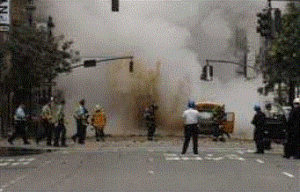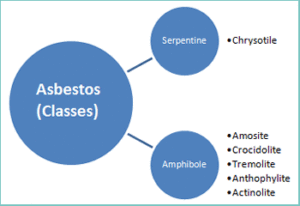 Asbestos in the Air
Asbestos in the Air
- Typical background asbestos levels in the air 0.0001 f/cc
- May be 2-10 X as high in urban areas compared with rural areas
- Some events may cause increase in levels
Asbestos in the Water
- 400,000 Miles of asbestos pipe carrying drinking water in North America
- Asbestos levels as high as 3000 million fibres per litre
- USA EPA standards 7 million fibres per litre
We are always happy to discuss your project – call us with any questions or concerns you may have or for a free estimate to for asbestos removal. This diagram shows where asbestos exist in a home or check out this timeline that shows when asbestos containing materials were used in building products across BC.
Classes of Asbestos and where they can be found

Chrysotile
This is the most commonly used form of asbestos and can be found today in roofs, ceilings, walls and floors of homes and businesses. Chrysotile asbestos also was used in automobile brake linings, pipe insulation, gaskets and boiler seals.
- Gaskets
- Cement
- Insulation
- Brake pads
- Brake linings
- Joint compound
- Roofing materials
These products sometime contained Amphibole Asbestos in the Past
- Asbestos Gaskets
- Asbestos Sheets
- Cigarette Filters
- Electrical Cloth & Electrical Panel Partition
- Fire Proofing & Prevention Materials
- Fume Hoods & Laboratory Hoods
- Plastics
- Vinyl Products
- Textile Cloths & Textile Garments
- Construction Products
- Adhesives and Gold Bond Adhesives
- Construction Mastics & Gunning Mix
- Ductwork Connectors & Flexible Duct Connectors
- Floor Backing & Drywall Taping Compounds
- Insulation
- Zonolite Insulation
The human health effects from long-term unsafe asbestos exposure are well documented. Asbestos fibres are easily inhaled and carried into the lower regions of the lung where they can cause fibrotic lung disease (asbestosis) and changes in the lining of the chest cavity (pleura). These diseases can lead to reduced respiratory function and death. Long-term inhalation of asbestos fibres also increases the risk of lung cancer and mesothelioma.

Snow in the Wizard of Oz was asbestos
Asbestosis is a chronic inflammatory and scarring disease affecting the tissue of the lungs. People with the condition may experience severe shortness of breath and are at an increased risk for certain cancers, including lung cancer and, less commonly, mesothelioma. Asbestosis specifically refers to fibrosis within the lung tissue from asbestos, and not scarring around the outside of the lungs.
Mesothelioma is a rare form of cancer that develops from cells of the mesothelium; the protective lining that covers many of the internal organs of the body. Signs and symptoms of mesothelioma include shortness of breath due to pleural effusion (fluid between the lung and the chest wall), chest wall pain and constitutional signs such as unexplained weight loss.
Projects that will create disturbance of asbestos-containing materials (ACMs) must comply with WorkSafeBC’s regulations and conform to the guidance document Safe Work Practices for Handling of Asbestos. WorkSafeBC defines an asbestos-containing material as a manufactured article or other material, other than vermiculite insulation, that would be determined to contain at least 0.5% or more asbestos if tested in accordance with one of the following methods:
(a) (i) Asbestos, Chrysotile by XRD, Method 9000 (Issue 2, dated August 15, 1994) in the NIOSH Manual of Analytical Methods, published by the United States National Institute for Occupational Safety and Health, Centre for Disease Control;
(ii) Asbestos (bulk) by PLM, Method 9002 (Issue 2, dated August 15, 1994) in the NIOSH Manual of Analytical Methods, published by the United States National Institute for Occupational Safety and Health, Centre for Disease Control; (iii) Test Method for the Determination of Asbestos in Bulk Building Materials (EPA/600/R-93/116, dated July 1993) published by the United States Environmental Protection Agency;
(b) Vermiculite insulation that would be determined to contain any asbestos if tested in accordance with the Research Method for Sampling and Analysis of Fibrous Amphibole in Vermiculite Attic Insulation (EPA/600/R-04/004, dated January 2004) published by the United States Environmental Protection Agency;
As asbestos is designated a K1 (confirmed human carcinogenic) material the employer must implement and exposure control plan to maintain worker exposure As Low as Reasonably Achievable (ALARA)
The asbestos-containing material can also be categorized as friable and non-friable. Friable asbestos is defined as material which, when dry, can be easily crumbled or powdered by hand pressure, or a material that is crumbled or powdered by hand pressure, or a material that is crumbled or powdered by WorkSafeBC. Determining condition of the asbestos and classifications would be used in assessing the level of action required for both sampling and abatement.
We can provide asbestos removal pricing and perform a hazmat survey to identify hazardous materials in your home or business. Read about our team’s high risk asbestos removal training and certification, which, along with our team’s experience allows us to put the correct asbestos removal procedures in place to safely remove asbestos from your home or business.
Asbestos Exposure Limits
The WorkSafeBC eight-hour time-weighted average (TWA) for asbestos fibres (all forms) is 0.1 fibre/cc. Exposure to these substances must be kept as close to zero as is reasonably achievable. Bulk samples are collected in accordance with NIOSH Analytical Method 9002 and the WorkSafeBC guideline document, Safe Work Practices for Handling Asbestos. Asbestos is designated as an ALARA substance; worker exposure to this product must be kept as low as reasonably achievable. Employers are required by WorkSafe BC to develop an exposure control plan (ECP) when workers are or may be exposed to airborne concentrations of these materials more than 50% of the exposure limit.



